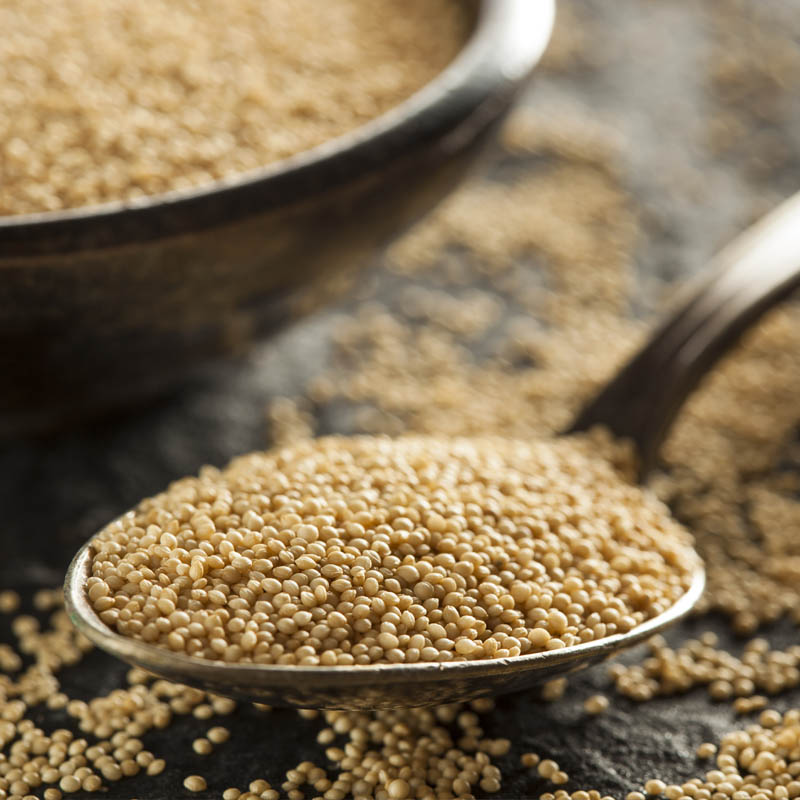By Foodfacts.mercola.com
Amaranth Advantage
Botanical name: Amaranthus
Cultivated by the Aztecs 8,000 years ago and still a native crop in Peru, the ancient history of amaranth can be traced to Mexico and the Yucatan Peninsula. Today, it’s grown in Africa, India, China, Russia, throughout South America, and emerging once again in North America.
Somewhat of an unknown quantity to many, amaranth is tall – often six feet – with broad green leaves, bright red or gold flowers, and around 60 different species. The flowers are made up of miniscule, grain-like buds, one reason why this plant often falls into the “grain” category. But amaranth isn’t technically a grain like oats, wheat, or rice. It’s sometimes referred to as a “pseudo-cereal” because its nutritional profile is very similar.
One of the most important aspects of this tiny grain is that it’s gluten-free. When ground, the flour is generally a pale ivory shade, although the red “buds” can be ground as well for a red-tinged and very healthful grain.
Being extremely dense, amaranth is too heavy to be used by itself. It’s best used with other grains for a lighter texture, and with a proven combination of ingredients like guar gum to impersonate gluten.
Cooking amaranth is comparable to cooking pasta or rice: boil plenty of water (six cups of water per one cup of amaranth), measure the grain into it, cook and stir for 15 to 20 minutes, drain, rinse, and eat.
Amaranth can be used as an exceptional thickener for sauces, soups, stews, and even jellies. Eaten as a snack, amaranth can have a light, nutty, or peppery-crunchy texture and flavor. Best of all, amaranth is even more nutritious than its true-grain counterparts.
Health Benefits of Amaranth
One reason amaranth is emerging into the forefront among grains is because of its remarkable nutrition. It’s higher in minerals, such as calcium, iron, phosphorous, and carotenoids, than most vegetables. It has truly remarkable protein content: cup for cup, 28.1 grams of protein compared to the 26.3 grams in oats and 13.1 grams in rice.
Amaranth is a great source of lysine, an important amino acid with protein content comparable to that of milk, more easily digested; neither can be said of other grains. To support this positive aspect of amaranth, it also contains primary proteins called albumin and globulins, which, in comparison with the prolamins in wheat, are more soluble and digestible.
One cup of raw amaranth contains 15 milligrams of iron, while white rice contains only 1.5 milligrams. One cup of raw amaranth also contains 18 milligrams of fiber; in comparison, white rice contains 2.4 grams.
At 105% of the daily value per serving, the manganese in amaranth is off the charts, yet it contains fewer carbohydrates. Amaranth contains more than three times the amount of calcium and it’s also high in magnesium, phosphorus, and potassium. Amaranth contains 6 to 10% oil, predominantly unsaturated, or around 77% unsaturated fatty acids, including linoleic acid, required for optimum nutrition. Not least in this list, amaranth is the only grain with documented vitamin C content.
|
Amaranth Nutrition Facts Serving Size: 4.9 ounces (139 grams), raw |
||
|
% Daily Value* Amt. Per Serving |
||
|
Calories |
716 |
|
|
Calories from fat |
113 |
|
|
Total fat |
14 g |
21% |
|
Saturated fat |
3 g |
14% |
|
Trans fat |
0 g |
0% |
|
Cholesterol |
0 g |
0% |
|
Sodium |
8 mg |
0% |
|
Total Carbohydrate |
127 g |
42% |
|
Dietary Fiber |
13 g |
52% |
|
Sugar |
3 g |
|
|
Protein |
26 g |
|
|
Vitamin A |
0% |
Vitamin C |
15% |
|
Calcium |
31% |
Iron |
82% |
|
*Percent Daily Values are based on a 2,000 calorie diet. Your daily values may be higher or lower depending on your calorie |
|||
Studies on Amaranth
A study on amaranth reported that its seeds contain not only important nutritional properties, but also phytochemical compounds like rutin and nicotiflorin, and peptides with the ability to help lower hypertension and incidences of cancer.
Researchers suggested further investigation on the function of health-beneficial peptides in amaranth, particularly lunasin, which was previously identified in soybeans and thought to have cancer-preventing benefits, as well as lowering incidences of chronic diseases, such as inflammation, diabetes, heart disease, and stroke.1
As cardiovascular disease (CVD) is linked to high blood cholesterol (hyperlipidemia), hypertension, obesity, and diabetes, scientists reported that reducing saturated fat while increasing unsaturated fatty acids can prevent CVD. Amaranth was studied in relation to these findings and found it to be potentially beneficial for CVD patients.
Test results also concluded that amaranth oil could be a functional food product for preventing and treating cardiovascular diseases.2
Amaranth Fun Facts
In Mexico, a bon-bon of sorts is made from popped amaranth mixed with sugar or honey, and called “dulce de alegria” or “sweet delight.” They’re formed into little skull-like confections and distributed during the Mexican “Día de Muertos” or “Day of the Dead” celebration.
Summary
Named after the Greek word “amarantos,” which means “one that does not wither,” colorful amaranth flower buds stay vibrant even after drying. Cultivated by the Aztecs 8,000 years ago, amaranth is still popular in many cultures, and becoming more so in recent years. It can be popped like corn, cooked similar to rice or pasta, or ground to flour.
The amazing thing about amaranth is how it compares nutritionally to other grains: far more iron, calcium, protein, manganese, fiber, and other phytonutrients than wheat or rice. Amaranth is one of the most protein-rich of any plant-based food, rivaling that of animal-based foods like cheese.
Ultimately, amaranth is a true powerhouse, known to help prevent a number of chronic health conditions such as diabetes, heart disease, cancer, and stroke. Luckily, it can be found in most supermarkets.


